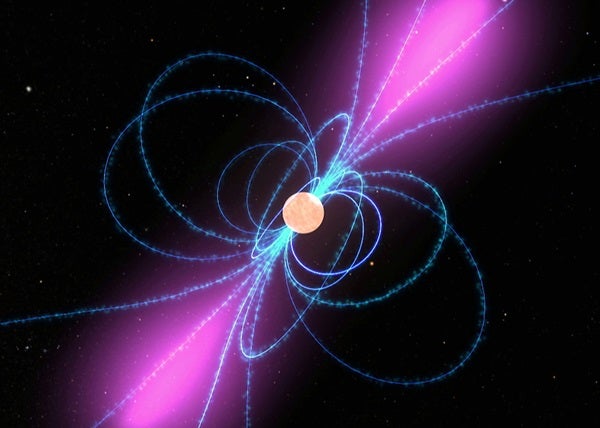That’s the fastest rate, but now, researchers have found a pulsar that has taken the title of slowest-spinning pulsar ever found. The pulsar, located some 14 million light-years away, rotates at a leisurely rate of once every 23.5 seconds — nearly three times slower than the previous record-holder.
The new slow-spin champ, outlined in a study published in The Astrophysical Journal, was discovered by a team led by Chia Min Tan, a doctoral student from The University of Manchester. As part of the LOFAR Tied-Array All-Sky Survey (LOTAAS), Tan and her colleagues searched the entire northern sky for interesting pulsars — and they found one in radio pulsar PSR J0250+5854.
What are pulsars?
When a massive star – between about 10 and 30 times the mass of the Sun – reaches the end of its nuclear-burning life, it goes out with a bang, exploding as a beautiful supernova. Though the vast majority of the exploded star’s material is blown outward during this violent event, it also causes the star’s core to collapse in on itself, leaving behind an absurdly dense stellar corpse known as a neutron star. The matter in these neutron stars is so tightly packed together that just a teaspoon of the material would weigh more than literally all of the fish in the sea.
And because these neutron stars are so much smaller than their original progenitors, to conserve angular momentum, they must drastically increase their spin rate. (Imagine the classic example of a figure skater rotating faster as they bring their arms inward.) Since these neutron stars also often have very strong magnetic fields, as the star quickly spins, the motion of its magnetic field generates a powerful electrical field, which in turn accelerates nearby charged particles to incredible speeds. This produces the powerful jets of charged particles and radiation that are the hallmarks of pulsars.
Why so slow?
Over time, the jets that shoot from a pulsar’s poles slowly rob the star of energy, which causes its spin to slow down. Eventually, after only about 10 to 100 million years, pulsars are thought to slow down to the point where the magnetic mechanism responsible for their jets shuts down. At this moment, scientists say the pulsar has reached the “death line.” According to the study, the strange thing about PSR J0250+5854 is that “the pulsar [is] beyond the conventional pulsar death line, where radio emission is expected to cease.”
“This discovery was completely unexpected,” said co-author Jason Hessels from the University of Amsterdam in a statement. “We’re still a bit shocked that a pulsar can spin so slowly and still create radio pulses. Apparently radio pulsars can be slower than we expected. This challenges and informs our theories for how pulsars shine.”
Moving forward, the team will continue to sift through data collected by the LOFAR survey, hoping to discover even more fascinating and mold-breaking pulsars. And as far as PSR J0250+5854 is concerned, they plan to use the European Space Agency’s XMM-Newton space telescope to further study the object in greater detail. “This telescope is designed to detect X-rays,” said Tan. “If the super-slow pulsar is detected as a source of X-rays, then this will give important insights into its history and origin.”










